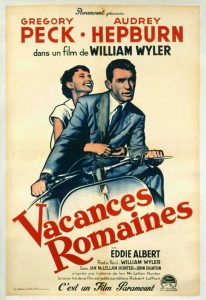
The item we have chosen is a poster of Roman Holiday that was promoted in France. This shows us that American studios such as Paramount used marketing as a way to target the audiences in Europe since American cinema had competition with new media such as the television, meaning that the cinema had become a less important attraction, and so it was necessary to attract international audiences to make profits.
In the 1950s, American cinema audiences were declining due to the new technology of the television, therefore many Hollywood studios decided to target the European market since it was a lot cheaper to film in Europe. However in this time, European audiences preferred to watch European films therefore American studios had to figure a way to keep audiences engaged whilst still containing a Hollywood style.
This poster for Roman Holiday was used as a marketing tool to advertise the film to French audiences. The poster portrays the film as a comedic, romantic adventure in Rome and uses the two stars, Audrey Hepburn and Gregory Peck as its main attraction. The film star was probably one of the most significant elements in film advertising, and the protection of those star images was the focus of most Hollywood publicity, which reached its peak during the classical era. Publicity departments were extremely cautious about the information which would have been given to the press when developing star publicity around the distinctive connection of private life and on-screen image.
From their inception, most movie ads were focused on stars, but this was only the tip of the iceberg. Many of the Hollywood publicity departments were enthusiastic about testing different star images and marketing and maintaining these personae. These tasks were undertaken by separate divisions of the publicity department, even though they were related to the process of film advertising. Posters, lobby cards, and press books were created in combination with the art department, while the advertisers are maintaining the star images. Talent agents and the stars’ publicists usually took over much of this work in the post-classical Hollywood era, usually for 10 percent of a star’s salary.
This poster is therefore important at showing how significant stars and the star system were to Hollywood studios of the 50s, as the film is effectively being sold just on the attraction of its two stars, rather than the plot or story. The poster enables Hollywood studious to access a larger audience (in this case, a French one) and so enables the studio to branch out internationally.
GOOD PRACTICE FEEDBACK
There is some good analysis of the poster here, emphasising its focus on stars as the ‘main attraction’, and the group do well to try to contextualise these observations with some wider information about the way studios handled publicity and how this operated as a key part of the studio system. The brief comparison to changes in the contemporary industry is a good way to highlight the historically specific approach to star making and star marketing that the Roman Holiday case study offers.